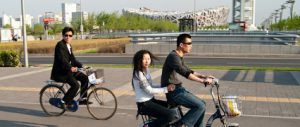Australian bike enthusiast Shannon Bufton is the founder of Smarter Than Car, an NGO that promotes cycling in Beijing. He is also co-creator of Beijing Bike Week, which holds its inaugural festival this month, running from March 15 to 18.
Olivia Boyd: What is Beijing Bike Week, in a nutshell?
Shannon Bufton: It’s a week of celebrations of cycling culture and an exhibition of high-end bicycles and unusual bicycles in a luxury-brand mall.
First of all, we’re trying to promote cycling to new crowds. We’re trying to promote the idea of recreational cycling and particularly the idea of bicycles as objects the middle class might be interested in – high-technology objects, new objects. We’re hoping we can get Chinese consumers interested in the modern bicycle.
The second part of it is that there is already a very strong bicycle subculture in Beijing. The mountains are so close to the city, and for a very long time there have been people going out there with their bikes and exploring the wilderness. There’s a strong community of cycling fans in Beijing and we want to support that.
OB: So it’s a recreational culture rather than one rooted in environmental concerns?
SB: Yes. It’s mostly about the bicycles themselves and it’s becoming more and more about recreational cycling. But there are hints of people associating green with that as well.
The government is also really trying to promote cycling. It’s bringing a bike-hire scheme into Beijing, which will start this year in Dongcheng district. They also had a public-transport campaign last year during which they sponsored cycling events. But, again, these events were more about recreational cycling. In China, it’s very difficult to promote the idea of utility cycling – to go out there and say to people: OK, you’ve had your car for a couple of years; now you should put it away and ride your bike again.
OB: Why?
SB: The image of the bicycle is still ingrained as a vehicle that the old China was using to move around. There are a lot of people who believe the idea of riding a bike around the city is a good one, but very few are prepared to lose face and go out there and do it. The director of [Chinese NGO] Friends of Nature, Li Bo, told me about an acquaintance, a successful business person, who decided to start riding his bike to work. He began getting calls from people asking if there was something wrong with his business and did he need to borrow money. So there is still a stigma attached to the bicycle.
OB: How can you tackle that?
SB: I spent about a year and a half with my organisation Smarter Than Car going to talk to different groups, universities and so on, giving lectures about sustainable cities and how the bicycle is the solution to some of our transportation problems, and is also a cool and fun way to get around. The response I got from people was: we get it, because we used to ride the bicycle and we probably know more about the bike than you do. But we’re not interested in getting back on our bikes. The overwhelming message was that the Chinese weren’t ready to embrace the idea of utility cycling.
So after burying my head in the sand for a while, I decided that maybe recreational cycling is a way to keep the bicycle in the culture, in people’s homes and minds and as part of their lives. There’s still a long way to go before someone who is putting their mountain bike on top of their four-wheel-drive and driving out to the mountains is going to start riding to work. But at least the bicycle is still there.
These people are also reconnecting with childhood ideas of riding a bike, which are about freedom and being able to go fast and have fun with your friends. That starts to reposition the bicycle, not as something that’s a tool but as something that’s an addition to your life and makes it a bit more liveable. And then slowly the perception of the bicycle can change into something that’s not necessarily negative. And the culture will come full circle.
OB: How fast is the recreational cycling world growing?
SB: Very fast. If you go out to the mountains to the west of Beijing on the weekends during spring and summer, there are hundreds of riders. Most of them are under 30 and there are groups of friends and couples, spending the day out there just enjoying the outdoors.
There’s also growing interest in fixed gear, which is a type of bicycle that has one gear and you can’t peddle backwards. In the last five to 10 years, fixed gear has seen a huge growth in the west. All those urban hipsters in New York and London are riding around on fixed-gear bikes, and I’d say the fixed-gear bicycle has had a part in inspiring the bicycle revolution in other parts of the world. Bicycling all of a sudden became cool and sexy and fashionable.
And this culture is catching on in China, too. If you walk past a shop today, you’ll see it’s full of young Chinese getting into fixed gear.
OB: How do Beijing’s overall cycling rates compare with other parts of the world?
SB: Overall, China is still doing OK. Beijing has a ridership rate of about 19%, while most American cities are still under 1%. But the problem is those people who are riding are basically riding because they have no other choice and as soon as they have the opportunity to choose a different type of transport, they will.
More of a worry is that the culture of using the bicycle to get from A to B is completely disappearing. This city used to be one of the most amazing bicycle cities in the world. If you talk to anyone who lived here in the ’70s or ’80s, they’ll tell you about bicycle super-highways and how it was really difficult to turn left because there were so many people coming past. My wife is a Beijinger and she tells me the stories of the freedom she had as a child to roam the city. She used to go into the Forbidden City with her friends and they would ride their bikes there.
Many western cities have started to talk about car-free zones and more sustainable transportation, and Beijing used to have it – it was all here. But it’s getting lost and no one seems to really care about that. I think it’s sad: in the west, we are trying to move towards what Beijing was before in terms of its pedestrianisation and bicycle-isation, and Beijing is trying to move towards a 1950s American city, full of cars and highways.
OB: What more could or should the government could be doing?
SB: They could do a lot for protecting the rights of cyclists. The traffic situation is not conducive to encouraging people to get on their bikes. The infrastructure is here, which is great. It’s still part of the National Planning Policy to have bicycle lanes — they’re just not well looked after. Cars park in them, taxis drive in them, people walk in them, and there’s no respect given to cyclists.
We did a report with Friends of Nature called “Bike for a Better Beijing”, where we put together a list of things we thought the government could do to improve the situation. One of those was to create some major cycling thoroughfares through the city and to start to protect those zones. Let the residents know these bike lanes are no-parking zones and have officers on hand to caution people who are in those lanes. And channel all of the energy of new cyclists into those spaces so that they can feel safe and others can see that they are moving faster and are looked after. That’s a way to encourage people to get back into cycling.
I think there are a lot of interesting things in Beijing’s old bicycle culture that could be adapted for future sustainable activities in cities.
OB: What sort of things?
SB: One of the great things here are the pop-up tricycle stalls. This idea of moving retail around to where people are is much more sustainable than having five different food shops in five different locations. In the old Beijing, bicycles and tricycles would go around the hutongs and ring a bell and people would know that was the flower-seller or someone was there to sharpen your knife. The idea that all you need is a bicycle or a tricycle and then you can service a population or provide a craft is a very sustainable way of thinking.
OB: How did you become so passionate about promoting cycling in Beijing?
SB: When I first came to China, I was working on large urban-design projects and I guess I got a bit disillusioned by the whole process. We sold our services as sustainability, but I knew the concepts we were putting in were going to be twisted this way and twisted that way and lose what they’re about by the time they got built.
I was really concerned about the way Chinese cities were heading, so I decided that I would move towards something more grass-roots. My wife and I thought let’s do something around the bicycle: it’s part of the city and has the potential to have a positive impact. And I fell in love with Beijing the first time I came here because I came on a bicycle.
Olivia Boyd is assistant editor at chinadialogue.
This article is published as part of our Green Growth project, a collaboration between chinadialogue and The Energy Foundation.
Homepage photo by Shannon Bufton (right) at a bicycling event in Guizhou province



